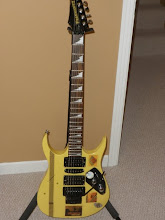Next came the experience with this guitar. The pickup combinations and open access to 24 frets was really nice. The neck seems huge (in length) and upper areas seem inviting. But two major problems were apparent right away, and one minor issue.
First, playing on the "medium" size frets is a pain. Any guitar I've owned always has low, small frets that don't try to trip up your fingers as you play. Bigger frets also make a guitar prone to "scalloping" (change in pitch as you apply pressure). And the Ibanez is no different. Yuuch.
Second, the bigger problem was the whammy kept the thing horribly out of tune, whether or not you actually touched it. My Strat has a floating vibrato, and I spent dozens of hours tinkering and toying with it so it would stay in tune. I had a choice: spend all that time again time on setting up this Ibanez, with no guarantee of success, or just install a locking vibrato system.
On the minor side, all the controls (including the whammy bar) were in the way of my right forearm. Just a little annoying, but I could live with it if I had to.
So, I decided to:
- install a Floyd Rose
- move the controls
- reduce the frets
The fret job alone is a tedious project in itself, so I opted to do just the first two tasks as this phase.
I didn't really know much about the Floyd Roses, so I started researching what I was in for. I really found these videos helpful in making a decision about what to get. Local stores wanted about $250 (and up) for licensed knock-offs, but I found an original "Made In Germany" on eBay for a little less than $200.
I spent a ton of time trying to find the specs on this particular Ibanez. Since Floyd Rose systems come in various sizes, I had to know which one to order. I opted for the 73mm bridge spacing, and the 'R2' (or #2) 43mm nut.
Once the kit arrived in the mail, I discovered it came without any instructions. More Googling, and it was time to begin.
Monday, June 7, 2010
Subscribe to:
Post Comments (Atom)

No comments:
Post a Comment